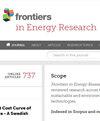Research on the performance of pump-turbine during the transition process from pump mode to turbine mode
IF 2.6
4区 工程技术
Q3 ENERGY & FUELS
引用次数: 0
Abstract
In current engineering, the transition process of pump turbines from pump to turbine mode mainly includes the shutdown process of pump operating and the startup process of turbine operating, and the switching of working conditions mostly depends on the opening and closing of the ball valve. While, this article focuses on the transitional process of pump turbine from pump to turbine condition without relying on ball valve, which will significantly reduce the response time of the unit and enable quick switching of operating conditions in emergency situations. In this study, the torque balance equation is employed to analyze the transition process of the entire flow system from pump to turbine operation. Additionally, the entropy production theory is utilized to investigate the correlation between pressure, flow state, and energy loss in the pump-turbine, shedding light on the changes in external characteristics through the evolution of internal characteristics. Furthermore, the transition process from pump mode to turbine mode is segmented into five stages based on the variations in the guide vanes (GV). The findings reveal that the rotation of GV triggers sharp fluctuations in static pressure, torque, and axial force. During stage four, the initiation of all three GV positions results in an increase in flow rate and torque, accompanied by a decrease in axial force. In stage two, the closure of GV leads to a decrease in pressure within the spiral casing (SC) and stay vanes (SV) domains, coupled with an increase in pressure in the bladeless zone, runner, and draft tube domains. Simultaneously, the pressure difference between both sides of the runner decreases significantly, directly causing a drop in torque and axial force. In stage three, GV closure interrupts the flow in the pump-turbine, resulting in significant backflow in the SC, SV, and runner domains, alongside high-speed circulation in the bladeless area. Moreover, the location of the high entropy production rate (EPR) value within the unit aligns with the reflux zone, indicating considerable energy loss attributable to reflux. The above research results will provide reference for the rapid switching of operating conditions of pump turbines in emergency situations.从泵模式到涡轮模式过渡过程中泵-涡轮机性能研究
在目前的工程中,水泵水轮机从泵工况到水轮机工况的过渡过程主要包括水泵运行的停机过程和水轮机运行的启动过程,而工况的切换大多依赖于球阀的启闭。而本文主要研究水泵水轮机从水泵工况到水轮机工况的过渡过程,不依赖球阀,这将大大缩短机组的响应时间,并能在紧急情况下快速切换工况。本研究采用扭矩平衡方程来分析整个水流系统从泵运行到水轮机运行的过渡过程。此外,还利用熵产生理论来研究泵-涡轮机中压力、流动状态和能量损失之间的相关性,通过内部特性的演变来揭示外部特性的变化。此外,根据导叶(GV)的变化,将从泵模式到涡轮模式的过渡过程划分为五个阶段。研究结果表明,GV 的旋转会引发静压、扭矩和轴向力的剧烈波动。在第四阶段,三个 GV 位置的启动都会导致流速和扭矩增加,同时轴向力减小。在第二阶段,GV 的关闭导致蜗壳 (SC) 和停留叶片 (SV) 域内的压力降低,同时无叶片区、流道和牵伸管域内的压力升高。同时,流道两侧的压力差显著减小,直接导致扭矩和轴向力下降。在第三阶段,GV 关闭中断了泵涡轮中的流动,导致 SC、SV 和流道域中出现大量回流,同时无叶片区域中出现高速循环。此外,装置内高熵产率(EPR)值的位置与回流区一致,表明回流造成了相当大的能量损失。上述研究成果将为紧急情况下快速切换水泵水轮机的运行条件提供参考。
本文章由计算机程序翻译,如有差异,请以英文原文为准。
求助全文
约1分钟内获得全文
求助全文
来源期刊

Frontiers in Energy Research
Economics, Econometrics and Finance-Economics and Econometrics
CiteScore
3.90
自引率
11.80%
发文量
1727
审稿时长
12 weeks
期刊介绍:
Frontiers in Energy Research makes use of the unique Frontiers platform for open-access publishing and research networking for scientists, which provides an equal opportunity to seek, share and create knowledge. The mission of Frontiers is to place publishing back in the hands of working scientists and to promote an interactive, fair, and efficient review process. Articles are peer-reviewed according to the Frontiers review guidelines, which evaluate manuscripts on objective editorial criteria
 求助内容:
求助内容: 应助结果提醒方式:
应助结果提醒方式:


